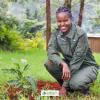To thrive, the world develops, constantly. Developmental needs push public and private entities to create goods, and services that meet the demand. They often use resources available in a given environment; such as human talents and skills, natural minerals, wild animals and plants, etc. to execute various solutions. This is called innovation. They then exchange these goods and services for something else, such as money (or other goods and services). This is called economics. Let’s consider:
Kizito lived in the lush green forested, mountainous village of Maeni. While they had several springs, the people from the neighboring dry village, Nyereri, often had to travel quite a distance to get drinking water. Recognizing the disparity, Mr. Kizito embarked on a mission to address this pressing need while safeguarding the environment for future generations. Mr. Kizito joined the local community in forest protection. This would ensure the abundance of the streams in Maeni for a while.
He contracted a few engineers and handymen from the community and piped purified water from a nearby spring to Nyereri. The people of Nyereri got water in their village at a convenience fee. This allowed development at Nyereri to accelerate. There was a need to have drinking water at Nyereri. This is the demand. Mr. Kizito, a private entity, came up with a piping solution. To make it work, he had to use resources from his environment such as; labor from handymen, expertise from engineers, and water purified and provided by nature. This is called innovation. The handymen and the engineers offered their services at a fee, and Mr. Kizito offered people water(a good). This is called economics.
This case study exemplifies sustainability in action: leveraging innovation and local resources to meet present needs without compromising the ability of future generations to thrive. It underscores the interconnectedness of environmental conservation, economic development, and social well-being, which are the pillars of sustainable development.
DEFINITION:
Sustainability can be defined as leveraging Innovation (I) to meet the needs of current generations without compromising the needs of future generations while ensuring a balance between economic (E) growth, environmental (E)care, and social well-being(well-being of the people{P}).
E-PIE stands for Environment, People, Innovation and Economy. These make the foundation of sustainability. Using them as a benchmark when planning projects or development will yield thriving ecosystems. Research has shown that projects and developments guided by the principles of E-PIE yield tangible benefits for communities while preserving natural resources for future generations.
The bond between Africa and her people is rooted in millennia of rich native knowledge and innovative practices. Many communities have been documented harnessing their rich cultural heritage to meet their needs sustainably. To develop sustainable solutions and projects for and in Africa means taking into consideration the indigenous social and environmental well-being. Join us as we explore what exactly sustainable development looks like for Africa (with live examples) in the next article, ‘Sustainable Development through the lens of Africa’.
1 July 2024 5:48pm
This is great. We are trying the E-PIE concept and thank you at Eco-Thrive for involving our Kieni to Flora Initiative on this.
1 July 2024 6:02pm
@EstherGithinji take a read at this.

Esther Githinji
WILDLABS
Fauna & Flora
3 July 2024 3:30pm
In reply to CathyNj
1 July 2024 6:02pm
@EstherGithinji take a read at this.
Yes, previously read it, very insightful.







CathyNj